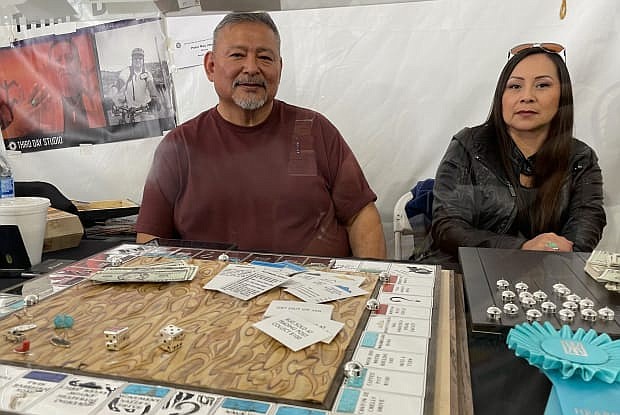‘Navajoland Monopoly’ big winner at Heard Indian Fair & Market in Phoenix
Phoenix art market welcomed more than 600 Indigenous artists from around the country March 4-5
PHOENIX — With properties called “Washboard Road” and “Chief Manuelito Drive” and two sterling silver dice, “Dinetah-Poly” is Raynard Scott’s rendition of the Monopoly board game.
“One of the cards says you hit a pothole, pay $50 for a new used tire,” Scott said. “It’s things that you would experience if you were living on the reservation — up in Navajoland.”
The Diné metalsmith’s take on the popular game earned him best of show at the 2023 Heard Guild Indian Fair & Market in Phoenix.
“When they called me, they told me it was stunned silence and I don’t remember that. Maybe it was,” he said. “It’s nice to get the accolades, the congratulations and the compliments from friends. I really appreciate that.”
This was his first time winning the top prize at the event, which had more than 600 Indigenous artists participating March 4-5.
Scott lives in Wide Ruins, Arizona, although he lived in Santa Fe and Tempe before moving to take care of his parents when the COVID-19 pandemic caused people to lockdown in 2020.
Winning the best of show is extra special, he said, because he called the Phoenix valley ‘Home,’ for many years.
“I feel like this is, this is a show that’s a lot more near to my heart,” Scott said.
He started working on “Dinetah-Poly” in February 2022. His inspiration came from his family playing Monopoly many evenings while sheltering at home in Wide Ruins.
He constructed each aspect of the game by hand, including the game pieces — a moccasin made from coral, a turquoise nugget and a Navajo rug, a Navajo man riding a horse, a pick-up truck and a Navajo woman herding two goats — all made of sterling silver.
Attendees were drawn to his booth to see “Dinetah-Poly,” which was surrounded by several ribbons it received from the art competition. They carefully studied the piece then commented on its uniqueness.
The heart of the board game is treated plywood that resembles the Southwest landscape.
“I think when I had the board’s center, everything just started clicking into place, the different avenues or the different properties,” Scott said.
Jewelry, pottery, carvings, weavings, sculptures, baskets and clothes were displayed and sold from inside rows and rows of tents situated on the museum grounds.
In addition to the art market, the event had artist demonstrations, a youth art show, music and dance performances.
“I especially want to thank the artists who’ve given us so many beautiful things to see this weekend,” Heard CEO David M. Roche said in opening remarks on March 4.
The range of artists taking part were from experienced to first-time participants.
Rosie Yellowhair, Diné, was among the established artists at the event.
She has been sandpainting for more than three decades and was demonstrating the intricate artwork.
“It keeps me close to my family members that are gone now,” Yellowhair said.
Lynn Traylor, Diné, won first place in Division F of the Diverse Art Forms category for a beaded design on a hat. This division consists of wearable items adorned with or without beads or quillwork, according to the museum.
The brim of the hat is beaded with four Navajo rug designs — the tree of life, Red Mesa, Two Grey Hills and chief’s blanket.
Completing the design is a hatband made of loom string and a small weaving comb and a small weaving batten that Traylor whittled by hand.
She named the piece, “Spider Woman’s Teaching.”
In Navajo oral history, Spider Woman taught the Diné how to weave and how to create beauty in their life and to share it.
Traylor, of Phoenix, said she was inspired by the generations of weavers in her family.
“It’s my interpretation of what Spider Woman has taught our people as far as weaving and living life in hozho,” she said.
It took her five weeks to bead the designs and she displayed the hat at the booth for her brand, Auntie Creations.
“Everyone likes it,” Traylor said about the hat. “They like to hear the story on the piece itself.”
SUBMIT FEEDBACK
Click Below to:




